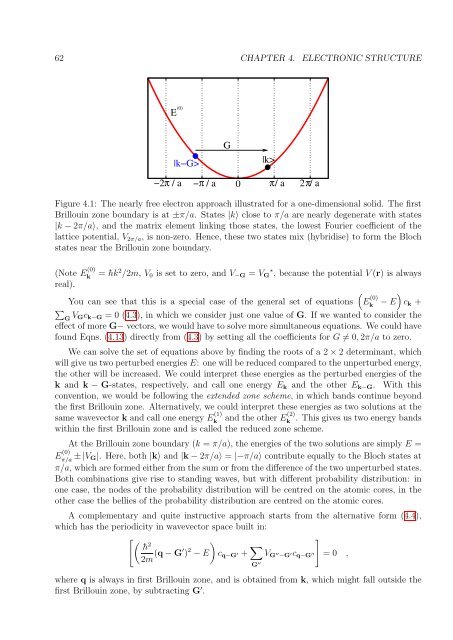Set of supplementary notes.
Set of supplementary notes.
Set of supplementary notes.
You also want an ePaper? Increase the reach of your titles
YUMPU automatically turns print PDFs into web optimized ePapers that Google loves.
62 CHAPTER 4. ELECTRONIC STRUCTURE<br />
E<br />
(0)<br />
|k−G><br />
G<br />
|k><br />
−2 π / a − π / a 0 π/ a 2 π/ a<br />
Figure 4.1: The nearly free electron approach illustrated for a one-dimensional solid. The first<br />
Brillouin zone boundary is at ±π/a. States |k〉 close to π/a are nearly degenerate with states<br />
|k − 2π/a〉, and the matrix element linking those states, the lowest Fourier coefficient <strong>of</strong> the<br />
lattice potential, V 2π/a , is non-zero. Hence, these two states mix (hybridise) to form the Bloch<br />
states near the Brillouin zone boundary.<br />
(Note E (0)<br />
k<br />
real).<br />
= h¯k 2 /2m, V 0 is set to zero, and V −G = V G ∗ , because the potential V (r) is always<br />
(<br />
E (0)<br />
k − E )<br />
c k +<br />
You can see that this is a special case <strong>of</strong> the general set <strong>of</strong> equations<br />
∑<br />
G V Gc k−G = 0 (4.3), in which we consider just one value <strong>of</strong> G. If we wanted to consider the<br />
effect <strong>of</strong> more G− vectors, we would have to solve more simultaneous equations. We could have<br />
found Eqns. (4.13) directly from (4.3) by setting all the coefficients for G ≠ 0, 2π/a to zero.<br />
We can solve the set <strong>of</strong> equations above by finding the roots <strong>of</strong> a 2 × 2 determinant, which<br />
will give us two perturbed energies E: one will be reduced compared to the unperturbed energy,<br />
the other will be increased. We could interpret these energies as the perturbed energies <strong>of</strong> the<br />
k and k − G-states, respectively, and call one energy E k and the other E k−G . With this<br />
convention, we would be following the extended zone scheme, in which bands continue beyond<br />
the first Brillouin zone. Alternatively, we could interpret these energies as two solutions at the<br />
same wavevector k and call one energy E (1)<br />
k<br />
and the other E(2)<br />
k<br />
. This gives us two energy bands<br />
within the first Brillouin zone and is called the reduced zone scheme.<br />
At the Brillouin zone boundary (k = π/a), the energies <strong>of</strong> the two solutions are simply E =<br />
E (0)<br />
π/a ± |V G|. Here, both |k〉 and |k − 2π/a〉 = |−π/a〉 contribute equally to the Bloch states at<br />
π/a, which are formed either from the sum or from the difference <strong>of</strong> the two unperturbed states.<br />
Both combinations give rise to standing waves, but with different probability distribution: in<br />
one case, the nodes <strong>of</strong> the probability distribution will be centred on the atomic cores, in the<br />
other case the bellies <strong>of</strong> the probability distribution are centred on the atomic cores.<br />
A complementary and quite instructive approach starts from the alternative form (4.4),<br />
which has the periodicity in wavevector space built in:<br />
[ ( ) h¯ 2<br />
2m (q − G′ ) 2 − E c q−G ′ + ∑ ]<br />
V G ′′ −G ′c q−G ′′ = 0 ,<br />
G ′′<br />
where q is always in first Brillouin zone, and is obtained from k, which might fall outside the<br />
first Brillouin zone, by subtracting G ′ .








